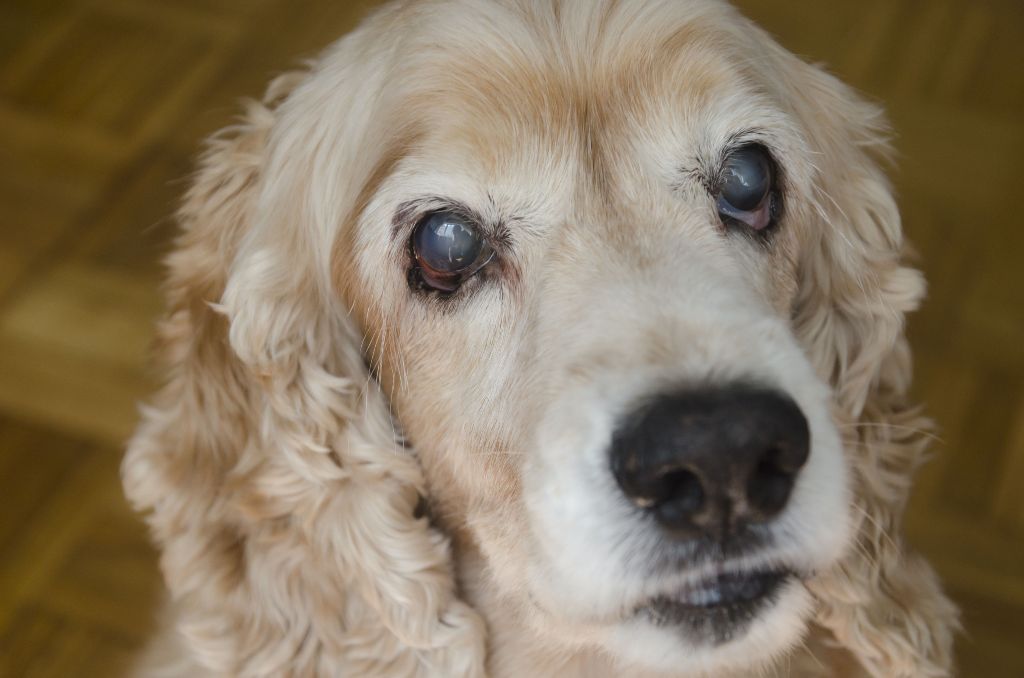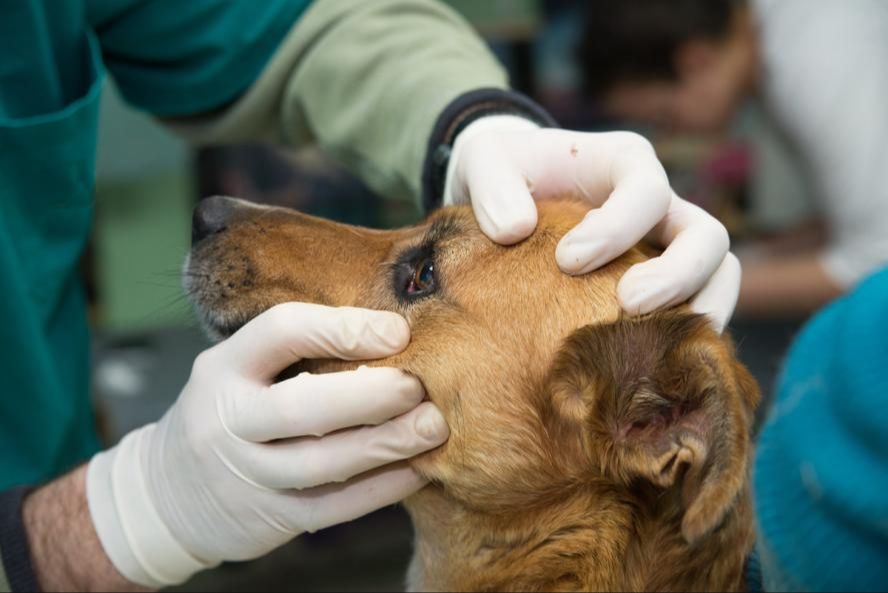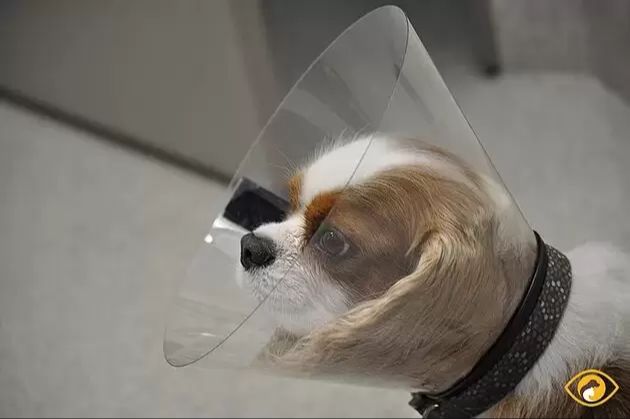What are cataracts in dogs?
Cataracts in dogs are a condition where the lens of the eye becomes progressively opaque, resulting in blurred vision. The lens is normally clear, allowing light to pass through and focus on the back of the eye (retina). As cataracts develop, the lens becomes cloudy, preventing light from properly reaching the retina (1).
Symptoms of cataracts in dogs include cloudy or bluish discoloration of the eye, clumsiness or hesitancy navigating surroundings, reluctance to go out at night or down stairs, increased frequency of running into objects, and overall vision loss (2). These symptoms tend to progressively worsen over time as the cataract matures.

While cataracts can develop from injury, inflammation, or genetics, most dog cataracts are caused by aging changes and oxidative damage that accumulate in the lens over time. Cataracts usually start developing in older dogs around 6-8 years of age, but can also occur in younger dogs depending on breed and genetics (1,3).
References:
(1) https://pubmed.ncbi.nlm.nih.gov/15762923/
(2) https://www.vet.cornell.edu/departments-centers-and-institutes/riney-canine-health-center/health-info/canine-cataracts
(3) https://www.ncbi.nlm.nih.gov/pmc/articles/PMC3168595/
Diagnosing cataracts in dogs
Cataracts in dogs are diagnosed through a thorough eye exam by a veterinarian. The examination will involve evaluating the eyes under magnification and with an ophthalmoscope to check for cloudiness in the lenses, which indicates cataracts.
Veterinarians will also perform several tests to determine the type and severity of the cataracts, including:
- Slit-lamp biomicroscopy – Provides a magnified view of the dog’s eyes to examine the lenses.
- Tonometry – Measures pressure inside the eye.
- Fluorescein stain test – Uses an orange dye to detect scratches or ulcers on the cornea.
- Schirmer tear test – Evaluates tear production.
- Electroretinography – Tests retina function by measuring electrical responses to light.
These tests help vets categorize the cataracts as incipient, immature, mature, or hypermature to determine the best treatment options.(1)

Treatment options for dog cataracts
There are a few main treatment options for dogs with cataracts:
Medications
While there are no eye drops that can reverse cataracts in dogs, some medications may help slow their progression. Topical drugs called aldose reductase inhibitors (ARIs) have shown potential to slow the formation of sugar cataracts in dogs when applied regularly. However, research is still limited and more studies are needed to confirm their effectiveness 1.
Surgery
The most effective treatment for dog cataracts is surgical removal. A procedure called phacoemulsification uses ultrasound waves to break up the cloudy lens and suction it out. An artificial lens can then be implanted to restore vision. Cataract surgery is typically very successful in dogs, with over 90% regaining functional vision. However, it can be expensive, with costs typically ranging from $2,000-$4,000 per eye 2.
Lifestyle changes
While no lifestyle changes can reverse cataracts, adapting the dog’s environment can help compensate for vision loss. Providing good lighting, removing tripping hazards, using baby gates, and keeping furniture arrangement consistent can all help a dog with cataracts navigate safely. As vision declines, focus on scent games, tactile toys, and audible cues.
Medications for dog cataracts
While there is no medication that can cure or reverse cataracts in dogs, eye drops may be prescribed to help control symptoms. Some commonly prescribed eye drops for dogs with cataracts include:
Artificial tear products – These lubricating eye drops, such as viscoelastic polymers or hyaluronic acid, can help soothe eye irritation and discomfort. They help moisturize the eye when tear production is impaired by cataracts.1
Anti-inflammatory eye drops – Medications containing steroids or nonsteroidal anti-inflammatory drugs (NSAIDs) may be prescribed to control inflammation and swelling in the eyes following cataract surgery or for secondary lens-induced uveitis. They help stabilize the eye environment.2
While medications can temporarily alleviate symptoms associated with cataracts in dogs, they do not reverse or cure the condition. Surgery remains the only treatment option to restore vision lost from cataracts in dogs. However, eye drops serve an important role in managing eye comfort and health during the condition.
Surgery for dog cataracts
Surgery is the main treatment for advanced cataracts in dogs. The procedure involves removing the lens that has become cloudy from cataracts and replacing it with an artificial lens implant. The surgery is called phacoemulsification and is performed under general anesthesia.
Cataract surgery is highly successful in dogs, with reported success rates of 85-90% based on studies with limited follow-up times. The success rate declines slightly over time but remains high. One study found a 90% success rate at 1 year after surgery and 80% at 3 years in dogs without other eye issues [1].

The cataract surgery procedure takes approximately 30-90 minutes depending on the case. Most dogs recover quickly after surgery but will need to wear an Elizabethan collar for 1-2 weeks to prevent rubbing at their eyes. Medicated eye drops are prescribed for 3-8 weeks after surgery. Vision typically improves within days but can take up to 8 weeks to fully return. Follow-up exams are done throughout the recovery period to monitor healing.
Lifestyle changes for dogs with cataracts
Making some adjustments to a dog’s lifestyle can help slow the progression of cataracts and maximize vision. Dietary changes are one of the most important lifestyle changes for dogs with cataracts.
Switching to a diet rich in antioxidants can be beneficial. Foods like blueberries, broccoli, and carrots contain lutein and zeaxanthin which support eye health (source). Some vets may recommend an antioxidant supplement as well.
Ensuring the dog’s environment is safe is also important. Remove tripping hazards, install ramps, and keep furniture in consistent places. Place food and water bowls in easily accessible areas. Consider fencing off hazards like pools and stairs. Placing bells on other pets can help the dog locate them. Keeping lighting consistent in the home also helps dogs adapt.
With some adjustments, blind and low vision dogs can continue to live full, enriched lives alongside their families.
Caring for a blind dog
Caring for a dog that has lost its vision can be challenging at first, but there are many techniques to help blind dogs navigate and live a fulfilling life. It’s important to focus on meeting all of your blind dog’s needs.
To help blind dogs get around, keep furniture in the same position and avoid leaving objects like shoes on the floor. Use mats with different textures to mark areas like food bowls. You can put up gates to block stairs or unsafe areas. Teach your dog commands like “wait” and “step” to navigate stairs. Use smells, sounds, and touches so your dog can find you or their bed. Consistency is key to easing anxiety.
Make sure to continue meeting your dog’s needs for exercise, mental stimulation, and socialization. Go on leash walks using familiar routes. Provide interactive toys that engage their nose and paws. Socialize them with other calm, friendly dogs. Give ample affection and playtime. Maintaining their routines and independence will improve their quality of life.
Also monitor for any other age-related health issues like arthritis. Keeping their environment clean and organized will help avoid trips and falls. While it takes adjustment, blind dogs can continue living happily with some extra training, patience, and care from their pet parents.
Costs of treating dog cataracts
Treating cataracts in dogs can be an expensive endeavor depending on the treatment path taken. Medications tend to be the most affordable option, while surgery is quite pricey.
Medication costs for managing dog cataracts typically range from $30-60 per month. Common medications prescribed include antioxidant supplements and eye drops like prednisolone to reduce inflammation. While medications don’t cure or reverse cataracts, they may slow their progression in some cases.
Surgery is the only way to fully restore vision obstructed by cataracts in dogs. However, cataract extraction surgery often costs $2,500-4,000 per eye according to sources like MarketWatch and Forbes. This covers the initial surgery fee, medications, anesthesia and hospitalization. Additional costs like diagnostic testing and follow-up exams can increase the total to $5,000 or more.
There are ways to reduce surgical costs, such as clinics affiliated with veterinary schools that offer discounted rates. Pet insurance plans that cover cataract surgery may also offset costs significantly. But even utilizing these options, owners should be prepared to spend thousands on surgery and aftercare if their dog’s vision is to be restored.
Outcome and prognosis
The prognosis for dogs with cataracts varies greatly depending on the treatment option. Without any treatment, cataracts will inevitably progress to complete blindness. However, with appropriate treatment, many dogs can regain vision and maintain a good quality of life.
Surgery offers the best outcome for restoring vision in dogs with cataracts. With modern phacoemulsification techniques, over 90% of dogs will have improved or restored vision after cataract surgery. The success rates are highest when surgery is performed before the cataract matures. Dogs that have surgery when the cataract is immature tend to regain complete, clear vision. As a cataract progresses, surgery may still restore functional vision but some cloudiness may remain.
Some medications aimed at slowing cataract progression in dogs may be modestly effective. However, medication alone cannot restore vision once cataracts have matured. At best, these medications may buy some extra time before surgery is required. But they do not significantly impact long-term prognosis compared to surgery.
Making lifestyle adaptations for a blind dog can help maintain quality of life after cataracts have fully matured. But blindness from untreated cataracts will still result in a major impact on quality of life. Blind dogs are prone to anxiety, disorientation and injuries. So while adaptations can help, they do not equate to a normal life. Surgery remains the best option for restoring vision and quality of life.
Overall, with appropriate surgery, the prognosis for dogs with cataracts is very good. Most dogs can regain vision and maintain a healthy, active lifestyle when treated promptly. Medications and lifestyle adaptations can help in the short-term but do not offer an equivalent long-term prognosis compared to cataract surgery.
Preventing cataracts in dogs
Preventing cataracts in dogs is possible through proper nutrition, lifestyle changes, and regular veterinary exams. Early detection and intervention can help reduce the risk of cataracts forming or progressing in dogs.

Getting your dog regular eye exams with your veterinarian is one of the most important things you can do to prevent cataracts. Cataracts typically develop slowly over time, so a veterinarian may be able to detect early changes in your dog’s lenses before cataracts form. This allows the vet to monitor progression and recommend treatments or lifestyle changes to potentially slow further development.
Providing excellent nutrition with antioxidants can also help prevent cataracts in dogs. According to research, vitamins C and E are antioxidants that can fight free radicals and reduce cataract risk. Talk to your vet about supplements or foods rich in these vitamins.
Other tips for preventing cataracts in dogs include protecting their eyes from UV damage, keeping diabetes under control if your dog is diabetic, avoiding toxin exposure, and maintaining an ideal body weight. Limiting sugar, avoiding steroids, controlling high blood pressure, and supporting eye health with supplements like lutein may also lower cataract risk.